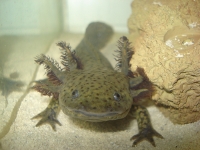The cells responsible for the salamander's famed ability to regenerate amputated limbs aren't pluripotent, as scientists have thought, a linkurl:study published online in Nature;http://www.nature.com/nature/journal/v460/n7251/abs/nature08152.html today reports. That's good news for regenerative medicine: If the mechanism salamander cells use for regrowing body parts doesn't depend on pluripotent stem cells, it may be easier than researchers have assumed to mimic that organism's regenerative strategy in potential therapies.
"This is a very important finding for this field and also for regenerative medicine in general," said regeneration biologist linkurl:Andras Simon;http://ki.se/ki/jsp/polopoly.jsp?d=27086&a=24117&cid=27089&l=en of the Karolinska Institutet in Sweden, who was not involved in the research. "The data very strongly suggest that during regeneration cells don't really shift lineage. I think many people expected more flexibility than what this study shows." Salamanders' regenerative abilities were thought to rely on the dedifferentiation of cells near...
 |
GFP-labeled Schwann cells Image: Dunja Knapp and Elly Tanaka |
 |
Interested in reading more?
Become a Member of
Receive full access to more than 35 years of archives, as well as TS Digest, digital editions of The Scientist, feature stories, and much more!
Already a member?




